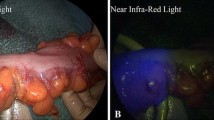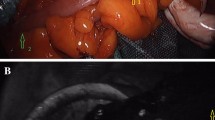Abstract
Recently, Indocyanine Green (ICG)-enhanced fluorescence has been introduced in laparoscopic colorectal surgery to provide detailed anatomical informations. The aim of our study is the application of ICG imaging during laparoscopic colorectal resections: to assess anastomotic perfusion to reduce the risk of anastomotic leak, to facilitate vascular dissection when vascular anatomy of tumor site is unclear, and to identify ureter to prevent iatrogenic injury. After the transection, 5 ml of ICG solution is intravenously injected. A Full HD IMAGE1S camera, switching to NIR mode, in few seconds provides a real-time angiography of colonic perfusion. After anastomosis, another bolus is injected to confirm the anastomotic perfusion. When the tumor is localized in difficult site, the fluorescence provides a real-time angiography of tumor area vascularization to perform the vascular dissection. When the tumor is tightly attached to the ureter, the ICG solution injection through the catheter allows ureter identification. From November 2016, 38 patients were enrolled: ten left colectomies, 22 right colectomies, three transverse resections, and three splenic flexure resections. In five cases, intraoperative angiography led to the identification of vascular anatomy. In one case the surgical strategy was changed. In one procedure, ureter identification allowed to prevent injury. Three postoperative complications that required surgical reoperation occured, of which one anastomotic leak, due to a mechanical problem. ICG-enhanced fluorescence imaging is a safe, cheap and effective tool to increase visualization during surgery. It can be employed also in small hospitals without learning curve. It is recommended to obtain additional information on anatomy and perfusion in colorectal surgery.



Similar content being viewed by others
References
Marescaux J, Diana M (2016) Looking at the future of surgery with the augmented eye. Ann Laparosc Endosc Surg 1:36
Vignali A, Giannotti L, Braga M, Radaelli G, Malvezzi L, Di Carlo V (2000) Altered microperfusion at the rectal stump is predictive for rectal anastomotic leak. Dis Colon Rectum 43(1):76–82
Kingham TP, Pachter HL (2009) Colonic anastomotic leak: risk factors, diagnosis, and treatment. J Am Coll Surg 208(2):269–278
Alander JT et al (2012) A review of indocyanine green fluorescence imaging in surgery. Int J Biomed Imaging 2012:940585
NCCN clinical practice guidelines in oncology: colon cancer; version 2.2017. (http://www.nccn.org). Accessed 13 Mar 2017
Diana M et al (2015) Intraoperative fluorescence based enhanced reality laparoscopic real-time imaging to assess bowel perfusion at the anastomotic site in an experimental model. Br J Surg 102:e169–e176
Dindo D, Demartines N, Clavien PA (2004) Classification of surgical complications: a new proposal with evaluation in a cohort of 6336 patients and results of a survey. Ann Surg 240(2):205–213
Ris F et al (2014) Near-Infrared (NIR) perfusion angiography in minimally invasive colorectal surgery. Surg Endosc 28:2221–2226
Karliczek A, Harlaar NJ, Zeebregts CJ, Wiggers T, Baas PC, Van Dam GM (2009) Surgeons lack predictive accuracy for anastomotic leakage in gastrointestinal surgery. Int J Colorectal Dis 24(5):569–576
Sharma A, Deeb AP, Rickles AS, Iannuzzi JC, Monson JR, Fleming FJ (2013) Closure of defunctioning loop ileostomy is associated with considerable morbidity. Colorectal Dis 15(4):458–462
Diana M et al (2014) Enhanced-reality video fluorescence: a real-time assessment of intestinal viability. Ann Surg 71(1):35–43
Degett TH, Andersen HS, Gogenur I (2016) Indocyanine green fluorescence angiography for intraoperative assessment of gastrointestinal anastomotic perfusion: a systematic review of clinical trials. Langenbecks Arch Surg 401:767–775
Boni L, David G, Dionigi G, Rausei S, Cassinotti E, Fingerhut A (2016) Indocyanine green-enhanced fluorescence to assess bowel perfusion during laparoscopic colorectal resection. Surg Endosc 30(7):2736–2742
Ashraf SQ et al (2013) The economic impact of anastomotic leakage after anterior resections in English NHS hospitals: are we adequately remunerating them? Colorectal Dis 15:e190–e198
Koperna T (2003) Cost-effectiveness of defunctioning stomas in low anterior resections for rectal cancer: a call for bench-marking. Arch Surg 138:1334–1338
Vonlanthen R et al (2011) The impact of complications on costs of major surgical procedures: a cost analysis of 1200 patients. Ann Surg 254:907–913
Diana M (2017) Enabling precision digestive surgery with fluorescence imaging. Transl Gastroenterol Hepatol 2:97
Author information
Authors and Affiliations
Corresponding author
Ethics declarations
Conflict of interest
All the authors has no conflicts of interest.
Research involving human participants and/or animals
The project has been submitted for the approval by Ethical Committee.
Informed consent
All the patients sign the informed consent.
Rights and permissions
About this article
Cite this article
Santi, C., Casali, L., Franzini, C. et al. Applications of indocyanine green-enhanced fluorescence in laparoscopic colorectal resections. Updates Surg 71, 83–88 (2019). https://doi.org/10.1007/s13304-018-00609-w
Received:
Accepted:
Published:
Issue Date:
DOI: https://doi.org/10.1007/s13304-018-00609-w




